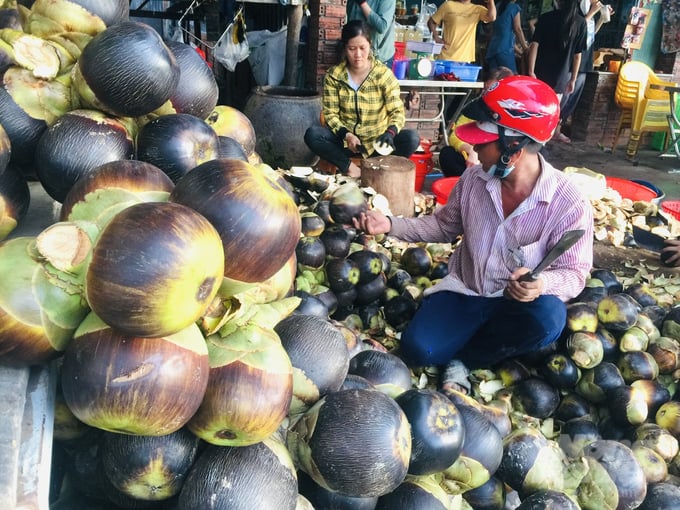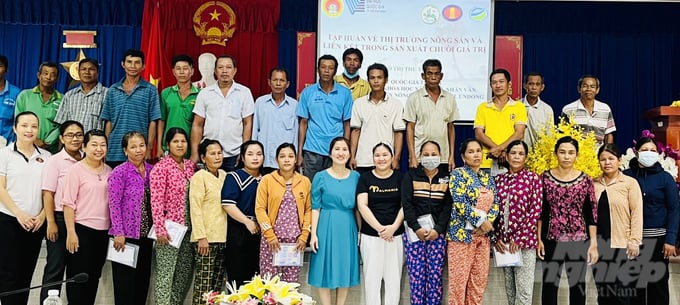May 23, 2025 | 20:43 GMT +7
May 23, 2025 | 20:43 GMT +7
Hotline: 0913.378.918
May 23, 2025 | 20:43 GMT +7
Hotline: 0913.378.918

Borassus trees are most commonly grown in the Bay Nui region (An Giang), where there are many Khmer people. Photo: Le Hoang Vu.
Borassus is a typical crop grown in large quantities in the Bay Nui region, concentrated in the Tri Ton district and Tinh Bien town (An Giang). Over the years, this crop has become a sustainable livelihood for the majority of Khmer households. Most parts of the Borassus tree are exploited and utilized by farmers to create many different useful products, bringing good income.
According to statistical results, in the Tri Ton district, there are nearly 11,000 Borassus trees scattered throughout the communes. Khmer farmers mostly exploit fresh Borassus fruit and honey juice to create food for daily consumption. They sold them to beverage shops and produced Borassus sugar to sell to consumers at markets. In addition, the process of producing products from Borassus trees of Khmer people is still traditional and manual, so the output and quality do not meet market requirements.

Harvested Borassus fruit. Photo: Le Hoang Vu.
Sustainable poverty reduction is one of the national target programs widely implemented across the country, especially in localities with ethnic minority areas, mountainous areas, and islands... Relying on the support of the State, represented by the National Office for Poverty Reduction, in localities, poverty reduction models are built and supported households to participate. However, any poverty reduction model is very difficult to replicate and must rely on local characteristics to build and develop.
Ms. Ngo Thi Thu Trang, Deputy Director of the Center for Rural Development - Saemaul Undong, the University of Social Sciences and Humanities, Vietnam National University, Ho Chi Minh City said: To support Khmer people to sustainably reduce poverty and avoid falling back into poverty, based on the specific livelihood of Borassus tree planting, Ministry of Labour, Invalids and Social Affairs, the National Office for Poverty Reduction in particular, in coordination with the Center for Rural Development - Saemaul Undong, the University of Social Sciences and Humanities, Vietnam National University, Ho Chi Minh City, build a production link model project along the value chain associated with Borassus trees.

Khmer households participate in the training class. Photo: Le Hoang Vu.
Accordingly, farmers are trained on production knowledge and market connection along the value chain "from supply to demand" and receive equipment support for the production of goods oriented towards clean production and quality improvement. Developing production along the value chain associated with Borassus trees helps Khmer people promote their internal strength and increase value from the crops and livestock that are associated with them daily. At the same time, the province exploits the unique properties of the Borassus tree to create typical products with geographical indications for the land of Tri Ton, where many Khmer people live.

Khmer people participate in planting new Borassus trees in O Lam commune, Tri Ton district (An Giang). Photo: Le Hoang Vu.
Along with the spirit of the Government's Project to plant one billion trees and the One Million Trees - For a Green Vietnam Program of the Central Executive Committee of the HCYU, the Center for Rural Development - Saemaul Undong coordinated with farmers to participate in training and plan over 50 new Borassus trees in the land around the pagoda. This event first of all contributes to the source of Borassus trees in the area, increasing the initiative in raw materials for farmers and demonstrating the sustainability of the project as the production life cycle continues. Next, this event improved the rural landscape environment to be more green, clean, and beautiful, contributing to building new rural areas in the locality.
Through the above events, the Center for Rural Development - Saemaul Undong desires to realize the mission of serving the community, contributing to bringing rural areas to develop and approaching urban areas, helping farmers' lives to become more prosperous. It is the operating philosophy that the Center has proposed since its inception.
Talking about planting and developing Borassus trees in the Bay Nui region, most Khmer people here are excited. The Borassus tree is an endemic plant in the Bay Nui region, it has the ability to adapt well to dry conditions and lack of water here. Due to its natural development ability, it is possible to form an organic Borassus tree area to build a brand, enhance the value of Borassus tree products, and aim for export.
Mr Chau Don in Chau Lang commune (Tri Ton district) owns 30 Borassus trees from his family and in addition, he rents some from other local people. When the sugar collection season starts in November (lunar calendar), lasting until April - May of the following year, on average, every day his family collects about 50 - 80 litres of Borassus sweet latex. With the amount of Borassus sweet latex obtained, it can be boiled to produce 15 - 20kg of Borassus sugar per day.
"Since I was young, I followed my father and uncles in the neighbourhood to get Borassus sweet latex so I got used to climbing. Tall Borassus trees are attached with bamboo stems with many small branches, making climbing easier, especially when it rains, the branches make climbing less slippery. This job helps my family raise my brother and me, my husband and I continue this job to earn an income to feed and provide education to our two children", Mr. Chau Don shared.

People participate in the movement to plant new Borassus trees. Photo: Le Hoang Vu.
Mr Truong Kien Tho, Deputy Director of An Giang Department of Agriculture and Rural Development, said that Borassus trees are currently grown concentrated in Tinh Bien and Tri Ton districts with over 35,000 trees. Thanks to its natural growth ability, the Borassus tree is assessed by An Giang province as being able to form an organic Borassus tree area, and gradually build An Giang's organic Borassus brand, contributing to improving life and reducing poverty for the Khmer ethnic minority region.
Translated by Hoang Duy

(VAN) The People's Committee of Tra Vinh province has approved an adjustment to the investment policy for the Green Hydrogen Plant project, increasing its area to approximately 52.76 hectares.
![Reducing emissions from rice fields: [2] Farmers’ commitment to the soil](https://t.ex-cdn.com/nongnghiepmoitruong.vn/608w/files/news/2025/05/05/dsc08881jpg-nongnghiep-140632.jpg)
(VAN) Clean rice cultivation model in Thuong Tan commune, Bac Tan Uyen district, is assisting local residents in achieving sustainable agriculture by substantially reducing costs, increasing productivity, and protecting the environment.

(VAN) At the conference to disseminate Resolution No. 68, AgriS introduced its digital agricultural ecosystem and reaffirmed its commitment to accompanying the Government in promoting private sector development and sustainable agriculture.

(VAN) 'Blue Ocean - Blue Foods' initiative is designed to restore marine ecosystems and establish sustainable livelihoods for local communities by cultivating a minimum of 1,000 hectares of cottonii seaweed in the first three years.
/2025/05/21/4642-3-112707_603.jpg)
(VAN) The V-SCOPE project has made direct contributions to three out of six pillars of the Comprehensive Strategic Partnership between Vietnam and Australia.

(VAN) Facing the threat of rabies spreading to the community, Gia Lai province urgently carries out measures to vaccinate dogs and cats on a large scale.

(VAN) Disease-free livestock farming not only protects livestock herds but also stabilizes production and livelihoods for many farmers in Tuyen Quang.